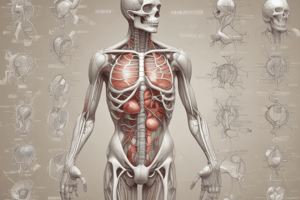Podcast
Questions and Answers
The Muscular system consists of muscles attached to the skeleton by ______
The Muscular system consists of muscles attached to the skeleton by ______
tendons
The Integumentary system provides ______ from the environment
The Integumentary system provides ______ from the environment
protection
The characteristic of life known as ______ refers to the condition in which the parts of an organism have specific relationships to each other
The characteristic of life known as ______ refers to the condition in which the parts of an organism have specific relationships to each other
organization
The Cardiovascular system transports ______ throughout the body
The Cardiovascular system transports ______ throughout the body
ANATOMY is the study of the structure and shape of the body and body parts and their relationships to one ______.
ANATOMY is the study of the structure and shape of the body and body parts and their relationships to one ______.
The female Reproductive system includes the ______ which produce milk
The female Reproductive system includes the ______ which produce milk
The goal of physiology is to understand and predict the body’s response to a ______.
The goal of physiology is to understand and predict the body’s response to a ______.
The ______ level is the basic and functional unit of all plants and animals.
The ______ level is the basic and functional unit of all plants and animals.
A group of similar cells and materials surrounding them is referred to as the ______ level.
A group of similar cells and materials surrounding them is referred to as the ______ level.
The goal of physiology is to understand how the body maintains ______.
The goal of physiology is to understand how the body maintains ______.
Flashcards are hidden until you start studying
Study Notes
Anatomy and Physiology
- Anatomy is the study of the structure and shape of the body and body parts and their relationships to one another.
- There are two approaches in studying anatomy: systemic approach (study of the body by systems) and regional approach (study of the body by areas).
Physiology
- Physiology is the study of the function or process of the body.
- Goals of physiology include understanding and predicting the body's response to a stimulus and understanding how the body maintains homeostasis.
Structural and Functional Organization
- Chemical level: atomic and chemical level.
- Cellular level: deals with organelles.
- Tissue level: group of similar cells and materials surrounding them, includes connective, muscular, epithelial, and nervous tissues.
- Organ level: two or more tissue types that together perform one or more common functions.
- Organ system level: group of organs classified as a unit to perform a common function or set of functions.
Organ Systems
- M.I.N.D.C.U.R.L.E.R.S. is an acronym for the organ systems in the human body:
- Muscular system: produces body movement, maintains posture, and produces body heat.
- Integumentary system: provides protection, regulates temperature, prevents water loss, and produces vitamin D precursors.
- Nervous system: detects sensations, controls movements, physiologic processes, and intellectual functions.
- Digestive system: performs mechanical and chemical processes of digestion, absorption of nutrients, and elimination of wastes.
- Cardiovascular system: transports nutrients, wastes, gases, and hormones, plays a role in immune response, and regulates body temperature.
- Urinary system: removes wastes from the blood, regulates pH, ion balance, and water balance.
- Respiratory system: exchanges O2 and CO2, regulates pH.
- Lymphatic system: removes foreign substances, combats diseases, maintains tissue fluid balance, and absorbs fat.
- Endocrine system: maintains homeostasis.
- Skeletal system: protects and supports, facilitates body movement, forms blood cells, and stores minerals and fat.
- Reproductive system (female): facilitates fertilization, fetal development, milk formation, and hormone production.
- Reproductive system (male): produces sperm and hormones.
Organism Level
- The organism level considers the whole organism, whether composed of one cell or trillions of cells.
Characteristics of Life
- Organization: condition in which the parts of an organism have specific relationships to each other.
Studying That Suits You
Use AI to generate personalized quizzes and flashcards to suit your learning preferences.




